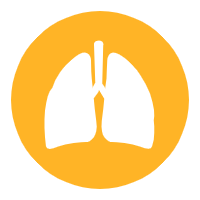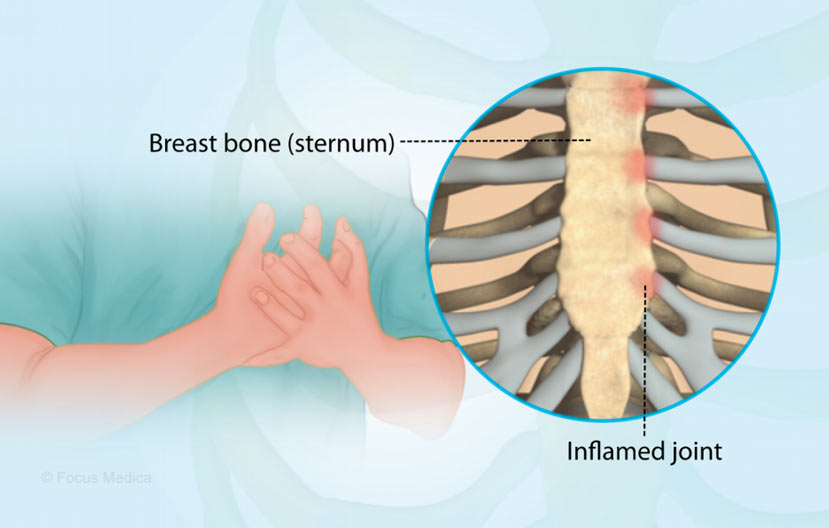Are you a golf lover who has been experiencing chest pain? It could be something serious like the symptoms of costochondritis. Costochondritis is an inflammation of the cartilage connecting your ribs to your breastbone and can cause sharp or dull pains in that area.
This blog post’ll discuss what causes costochondritis, its symptoms, and how to treat it. Read on for more information about this condition!
An Overview of Costochondritis
Costochondritis is an inflammation of the cartilage connecting your ribs to your breastbone, which can cause sharp or dull pains in that area. This condition can occur due to various causes, including repetitive activity such as playing golf or weightlifting, direct trauma to the area, infection, and underlying medical conditions like rheumatoid arthritis. It is important for golfers experiencing chest pain to be aware of costochondritis and understand how it may affect their game.
The most common symptom associated with costochondritis is chest pain—which can range from sharp and localized aches to more diffuse pain when deep breathing and coughing—along with tenderness in the affected area. Other symptoms may include swelling in the chest, pain in the shoulders and arms, and fatigue. In some cases, costochondritis may be accompanied by fever and body aches if caused by an underlying infection.
Symptoms to Look Out For
Sharp or dull chest pain
This symptom is the most common sign of costochondritis and can range from a localized ache to more diffuse pain when deep breathing or coughing.
Tenderness in the chest
This includes any tenderness felt during physical contact with the affected area, such as when pressing lightly with your fingers.
Swelling in the chest
Swelling may occur around the ribs and breastbone due to inflammation caused by costochondritis.
Pain in shoulders and arms
In addition to chest pain, people with costochondritis can experience radiating pain down their arms and into their shoulders.
Fatigue
While fatigue does not always accompany costochondritis, some people may experience tiredness and lack energy.
Fever
A fever may occur if an underlying infection causes costochondritis.
Body aches
In some cases, body aches can be a symptom of costochondritis, fever, and fatigue.
Difficulty breathing
If the chest pain is severe enough, it can make breathing more difficult, especially during deep breaths or coughing.
Coughing up blood
While rare, coughing up blood can also be a sign of costochondritis in some cases. If this occurs, seek medical attention immediately, as it may indicate a more serious condition.
Causes of Costochondritis
Repetitive use
Repeatedly engaging in activities such as golf swings or weightlifting can strain the muscles and tissues of the chest, leading to costochondritis.
Direct trauma
Injury or direct trauma to the area can cause inflammation in the ribs and breastbone, resulting in costochondritis.
Infection
Viral, bacterial, and fungal infections may also lead to cartilage inflammation connecting your ribs to your breastbone, causing costochondritis.
Rheumatoid arthritis
This autoimmune disorder can cause stiffness and pain in the chest due to inflammation of the affected area, which may result in costochondritis.
Brucellosis
This infection, caused by Brucella, can cause chest inflammation and costochondritis.
Fibromyalgia
Fibromyalgia is a chronic condition that causes widespread pain throughout the body, including in the chest area, that could lead to costochondritis.
Ankylosing spondylitis
A type of arthritis that affects the spine may also cause inflammation in the chest resulting in costochondritis.
Osteoarthritis
This condition involves wear and tear of joints due to age or injury, which can also result in chest pains related to costochondritis.
Stress
Excessive stress can cause tense muscles in the chest that may result in costochondritis.
How to Diagnose Costochondritis
Diagnosis of costochondritis is based on a physical examination and medical history. Your doctor may also order an X-ray or MRI to confirm the diagnosis and rule out other possible causes of chest pain. Sometimes, laboratory tests such as bloodwork may be necessary to check for infections or underlying diseases.
Treating Costochondritis
Treatment of costochondritis depends on the cause. If an infection is causing your condition, your doctor may prescribe antibiotics. Over-the-counter medications such as ibuprofen can help reduce inflammation and pain associated with costochondritis; however, it is important not to take too much as this can increase the risk of side effects.
Other treatments include rest and lifestyle changes such as avoiding activities that exacerbate the symptoms, and physical therapy to help strengthen muscles. If the condition is severe or persistent, injections of corticosteroids may be recommended.
Exams and Tests
The following exams and tests may be done to diagnose costochondritis:
Physical examination. Your doctor will look for tenderness in the chest when you press on it lightly with your fingers.
- X-rays or MRI scans to rule out other possible causes of chest pain, such as fractures or tumors.
- Bloodwork to check for infections or underlying diseases causing costochondritis.
- Stress test to check for signs of heart problems.
How to Prevent Costochondritis from Returning
Preventing costochondritis from returning can be achieved by making lifestyle changes and avoiding activities that cause chest pain or tenderness. Begin a gentle exercise program to help increase strength and flexibility in the affected area.
Your doctor may recommend specific exercises and stretches depending on your condition. Try maintaining good posture during everyday activities, as slouching can strain the chest muscles. Avoid lifting heavy objects with extended arms as this could pressure the chest muscles and worsen symptoms.
If underlying conditions are causing costochondritis, it is important to manage them properly to prevent flare-ups. For example, maintaining a healthy weight for those with obesity, getting regular exercise for those with chronic fatigue syndrome, or controlling stress levels for those suffering from anxiety.
Tips for Living with Costochondritis
Living with costochondritis can be difficult as the pain and discomfort make everyday activities more challenging. However, there are some tips you can follow to help manage your symptoms and reduce flare-ups.
Firstly, it is important to rest when needed to avoid overexerting the chest area. This means avoiding activities such as carrying heavy objects or lifting weights that could aggravate your condition. Try gentle yoga, or Tai Chi exercises that target chest muscles but do not strain them excessively. Additionally, maintain good posture throughout the day, as slouching can put additional pressure on your chest muscles and worsen inflammation.
FAQs
Q: How do you heal costochondritis?
A: Treatment for costochondritis often includes pain relief medications, such as ibuprofen or acetaminophen. Cold compresses are also sometimes recommended to reduce inflammation and decrease the amount of discomfort you may feel. Additionally, your doctor may suggest physical therapy to help you stretch and strengthen the chest muscles.
If costochondritis is causing severe pain or difficulty breathing, it is important to seek medical attention promptly.
Q: Does costochondritis show up on an X-ray?
A: Depending on the severity of costochondritis, it may appear on an X-ray. In some cases, imaging tests such as computed tomography (CT) scans, or magnetic resonance imaging (MRI) scans might be needed to determine the cause and extent of your costochondritis.
Q: Does costochondritis go away?
A: With treatment, costochondritis can be managed, and the symptoms can improve. However, preventing flare-ups by avoiding activities that may lead to chest pain or discomfort is important. You should also maintain good posture and practice stress-reduction techniques to reduce the risk of exacerbating your symptoms.
Conclusion
Costochondritis is a condition that can cause inflammation and chest pain. Although it is typically not serious, it can be quite uncomfortable and make everyday activities more difficult. It is important to seek medical attention if the symptoms are severe or become worse over time. Treatment includes medications for pain relief, physical therapy, lifestyle changes, and avoiding activities that may worsen your condition. By following these tips, you can help reduce the risk of flare-ups and manage your costochondritis more effectively.






